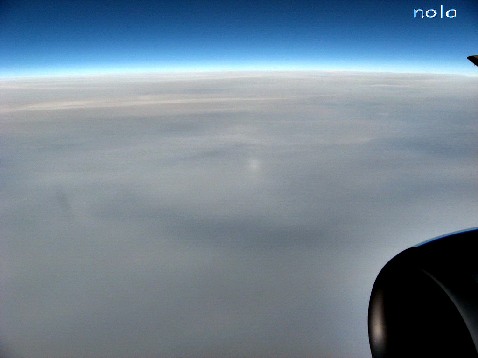The photo above is intended to be food for thought, as it shows a rather controversial phenomenon.
Mónika Bodó took this picture on 27 March 2008 between 16:43 – 16:46 on a flight from Athens to Budapest. As an air hostess, she flies several times a week, and very often photographs subhorizon halos and glories. This was the first time, however, when she saw such a phenomenon. For comparision, the original version of the above photo ( 1 ) and another image are also available ( 2 - 3 ).
The bright spot in the picture is at the antisolar point, the location of both the glory and the "subanthelion". A short time earlier, the shadow of the airplane had been photographed ( 4 ) and it was exactly at this point where the brightening developped. On the other side of the airplane, the bottom of the 22° halo, subsun and subparhelia were visible ( 5 – 6 ).
When the "subanthelion" is photographed, it tends to appear where the diffuse anthelic arcs forming a large X cross the subparhelic circle, and the brightening seems to be caused by the meeting of these halos. On 7 August 2006, Francesco De Comité took a photo of these antisolar halos, and there the shape of the "subanthelion" is clearly a square, thus suggesting that it is not a separate halo form, just a bright spot created by the crossing anthelic arcs ( 7 ). Another image was taken by Susanne Danßmann on 3 June 2006 ( 8 ), and one can be seen in Walt Tape's Atmospheric Halos (page 71).
What makes Mónika Bodó's observation very interesting is that even though the spot looks like a halo, the subparhelic circle does not show up in the images, and there are no other halos visible in the antisolar region. If it is really a halo, her photograph seems to show one not caused by the crossing of these arcs.
There have been other observations of a single bright spot at the antisolar point, often taken as a distant glory. It might be, however, that it is indeed an independent halo form. So far no sufficient explanation exists, suggestions and opinions are welcome.

in Finnish halo observations archives we have one or two similar cases. Later on, after the effect was seen again, it was concluded that this is glory, if I remember correctly. But who knows, sometimes it could be a halo. This is exceptionally well documented in that also the sun side was observed - and there were halos.
ReplyDeleteAnyway, Monica is in a unique position for subhorizon discoveries. Maybe she will provide us one day with first photos of sub120 parhelia.
I made these simulations some years ago and it looked like mighty intensive 22 halo was needed for this subanthelion to appear. On the other hand, the subtle intensity features previouly seen only in simulations do show up in lamp displays. Who knows, maybe with lamp even the more subtle features, like the diffuse equivalents of 22 and 46 halos in the anthelic region could show up in random orietend dust display. The problem might be the rarity of sole random orietation in snow gun generated displays.
ReplyDelete